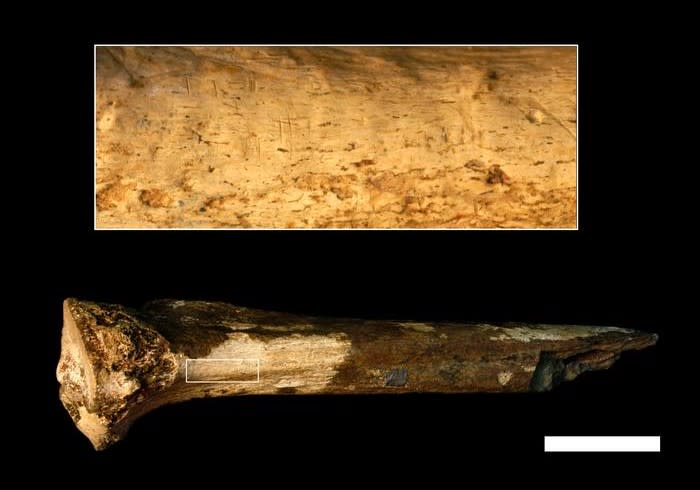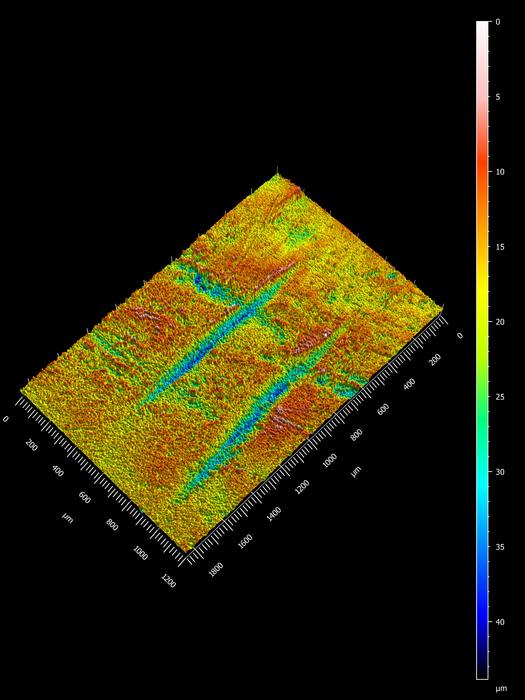Ancient human ancestor bone was 'butchered by another ancestor for meat'

The bone of an ancient human relative shows signs of being cut with stone tools - by another human relative looking to cut off meat to eat.
The nine cut marks on a 1.45 million-year-old left shin bone from a relative of Homo sapiens were found in northern Kenya.
Analysis of 3D models of the fossil’s surface revealed that the cut marks were dead ringers for the damage inflicted by stone tools.
National Museum of Natural History paleoanthropologist Briana Pobiner said, “The information we have tells us that hominins were likely eating other hominins at least 1.45 million years ago.
“There are numerous other examples of species from the human evolutionary tree consuming each other for nutrition, but this fossil suggests that our species’ relatives were eating each other to survive further into the past than we recognised.”
Read more: Melting snow in Himalayas drives growth of green sea slime visible from space
Pobiner first encountered the fossilised tibia, or shin bone, in the collections of the National Museums of Kenya’s Nairobi National Museum while looking for clues about which prehistoric predators might have been hunting and eating humans’ ancient relatives.
With a handheld magnifying lens, Pobiner pored over the tibia looking for bite marks from extinct beasts when she instead noticed what immediately looked to her like evidence of butchery.
Pobiner sent moulds of the cuts—made with the same material dentists use to create impressions of teeth—to co-author Michael Pante of Colorado State University.
Pante created 3D scans of the moulds and compared the shape of the marks to a database of 898 individual tooth, butchery and trample marks created through controlled experiments.
Read more: A 1988 warning about climate change was mostly right
The analysis positively identified nine of the 11 marks as clear matches for the type of damage inflicted by stone tools. The other two marks were likely bite marks from a big cat, with a lion being the closest match.
According to Pobiner, the bite marks could have come from one of the three different types of sabre-tooth cats prowling the landscape at the time the owner of this shin bone was alive.
By themselves, the cut marks do not prove that the human relative who inflicted them also made a meal out of the leg, but Pobiner said this seems to be the most likely scenario.
She explained that the cut marks are located where a calf muscle would have attached to the bone—a good place to cut if the goal is to remove a chunk of flesh. The cut marks are also all oriented the same way, such that a hand wielding a stone tool could have made them all in succession without changing grip or adjusting the angle of attack.

“These cut marks look very similar to what I’ve seen on animal fossils that were being processed for consumption,” Pobiner said. “It seems most likely that the meat from this leg was eaten and that it was eaten for nutrition as opposed to for a ritual.”
While this case may appear to be cannibalism to a casual observer, Pobiner said there is not enough evidence to make that determination because cannibalism requires that the eater and the eaten hail from the same species.
The fossil shin bone was initially identified as Australopithecus boisei and then in 1990 as Homo erectus, but today, experts agree that there is not enough information to assign the specimen to a particular species of hominin.
The use of stone tools also does not narrow down which species might have been doing the cutting.
Recent research from Rick Potts, the National Museum of Natural History’s Peter Buck Chair of Human Origins, further called into question the once-common assumption that only one genus, Homo, made and used stone tools.
So, this fossil could be a trace of prehistoric cannibalism, but it is also possible this was a case of one species chowing down on its evolutionary cousin.
None of the stone-tool cut marks overlap with the two bite marks, which makes it hard to infer anything about the order of events that took place.
For instance, a big cat may have scavenged the remains after hominins removed most of the meat from the leg bone. It is equally possible that a big cat killed an unlucky hominin and then was chased off or scurried away before opportunistic hominins took over the kill.
One other fossil—a skull first found in South Africa in 1976—has previously sparked debate about the earliest known case of human relatives butchering each other. Estimates for the age of this skull range from 1.5 to 2.6 million years old.
To resolve the issue of whether the fossil tibia she and her colleagues studied is indeed the oldest cut-marked hominin fossil, Pobiner said she would love to reexamine the skull from South Africa, which is claimed to have cut marks using the same techniques observed in the present study.
She also said this new shocking finding is proof of the value of museum collections.
“You can make some pretty amazing discoveries by going back into museum collections and taking a second look at fossils,” Pobiner said. “Not everyone sees everything the first time around. It takes a community of scientists coming in with different questions and techniques to keep expanding our knowledge of the world.”
Watch: Most of us have herpes thanks to ancient interspecies sex


